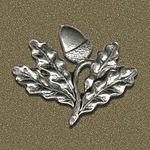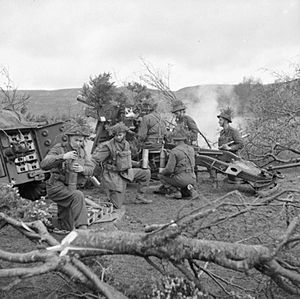South Nottinghamshire Hussars facts for kids
Quick facts for kids South Nottinghamshire Hussars |
|
|---|---|

Badge of the South Nottinghamshire Hussars
|
|
| Active | 1826 – 2014 2018– |
| Country | |
| Branch | |
| Type | Yeomanry |
| Size | Regiment |
| Part of | Royal Artillery |
| Engagements | Second Boer War First World War
|
| Battle honours | See battle honours below |
The South Nottinghamshire Hussars is a special unit of the British Army. It started as a group of volunteer cavalry soldiers in 1794. Cavalry means soldiers who fight on horseback. In 1922, the unit changed to become an artillery group, which means they use large guns. Today, it is part of the 103 (Lancashire Artillery Volunteers) Regiment in the Royal Artillery.
Contents
History of the Hussars
How the Unit Started
The South Nottinghamshire Hussars began in 1794. It was first called the Nottinghamshire (South Nottinghamshire) Yeomanry Cavalry. This was during the French Revolutionary Wars, when Britain needed more soldiers. In 1826, its name changed to the Southern Nottinghamshire Regiment of Yeomanry Cavalry.
Fighting in the Second Boer War
The Yeomanry units were not meant to fight outside of Britain. But in December 1899, the British Army faced some tough losses in the Second Boer War. So, the government decided they needed more troops. They asked volunteer groups like the Yeomanry to help.
The South Nottinghamshire Hussars sent a group of about 115 men. These soldiers were trained as mounted infantry, meaning they rode horses but fought on foot. This idea worked well. From 1901 to 1908, the unit was known as the Nottinghamshire Imperial Yeomanry (South Nottinghamshire Hussars). Around 1910, they moved to a new training hall in Nottingham.
The First World War (1914-1918)
When the First World War began in August 1914, many soldiers in the Territorial Force (a home defense group) volunteered to serve overseas. Because of this, units were split into different "Lines."
1st Line: Fighting Overseas
The 1st Line of the South Nottinghamshire Hussars was formed in Nottingham in 1908. They became part of a larger group called the Nottinghamshire and Derbyshire Mounted Brigade. This brigade fought in the Gallipoli Campaign in 1915.
In 1916, the unit moved to Salonika (now Thessaloniki) in Greece. By 1917, they were in Egypt. In 1918, they stopped fighting on horseback and became a machine gun unit. They were then called the 100th (Warwickshire and South Nottinghamshire Yeomanry) Battalion, Machine Gun Corps. This battalion served in France until the war ended.
2nd Line: Home Defense
The 2nd Line regiment started in Nottingham in September 1914. They trained at Colwick Racecourse and later moved to Ollerton. Their job was to defend Britain.
In 1916, many Yeomanry units, including this one, changed from cavalry to cyclists. This meant they rode bicycles instead of horses. The regiment stayed near Canterbury in England for the rest of the war.
Between the World Wars
After the First World War, leaders decided that cavalry (horse soldiers) were not as important anymore. Many Yeomanry units, including the South Nottinghamshire Hussars, became artillery units. In 1922, they were renamed the 107th (South Nottinghamshire Hussars Yeomanry) Army Brigade, RFA. They used large guns instead of horses.
In 1924, the RFA became part of the Royal Artillery. In 1938, their brigades were renamed as regiments. In 1939, as another war seemed likely, the 107th formed a new, similar unit called the 150th (South Nottinghamshire Hussars) Regiment, RHA.
The Second World War (1939-1945)
107th (South Nottinghamshire Hussars) Regiment, RHA
At the start of the war, the 107th Regiment had two batteries (groups of guns), each with 8 field guns. They served in Palestine and later in Egypt. They fought in important places like Mersa Matruh and Tobruk.
In April 1942, the 107th Regiment gained a third battery. Later, parts of the regiment were reformed into the 107th (SNH Yeo) Medium Battery RA. This battery fought in North Africa, Sicily, and Italy. In 1944, they returned to the UK and then served in North-West Europe.
Equipment Used
During the war, the 107th Regiment used different types of artillery guns, including:
- 18-pounder field guns
- 4.5-inch howitzers
- 25-pounder guns
150th (South Nottinghamshire Hussars) Regiment, RHA
The 150th Regiment also started with two batteries. In 1940, it was renamed the 150th (South Nottinghamshire Hussars Yeomanry) Field Regiment RA. They got new 25-pounder field guns in November 1940.
The regiment landed in France in June 1944, a few days after D-Day. However, the 150th Regiment was disbanded in November 1944. This happened because the British Army needed more infantry (foot soldiers) and had too many gunners without guns.
After the Wars
After the Second World War, in 1947, both regiments were brought back. The 107th became the 307th (South Nottinghamshire Hussars Yeomanry) Field Regiment, RA. The 150th became the 350th (South Nottinghamshire Hussars Yeomanry) Heavy Regiment, RA.
Over the years, these units went through more changes and mergers. In 2014, the unit was put on hold. But in January 2018, it was started again as C (South Nottinghamshire Hussars) Troop. It is now part of the 103rd (Lancashire Artillery Volunteers) Regiment, RA.
Regimental Museum
You can learn more about the South Nottinghamshire Hussars at The Royal Lancers and Nottinghamshire Yeomanry Museum. It is located at Thoresby Hall in Nottinghamshire.
Battle Honours
Battle honours are special awards given to military units for their bravery and success in battles. The South Nottinghamshire Hussars earned many battle honours. The ones in bold are proudly displayed on their regimental flags.
| Second Boer War | South Africa 1900–02 |
| First World War | Hindenburg Line, Épehy, St Quentin Canal, Beaurevoir, Selle, Sambre, France and Flanders 1918, Struma, Macedonia 1916–17, Suvla, Scimitar Hill, Gallipoli 1915, Egypt 1915–16, Gaza, El Mughar, Nebi Samwil, Palestine 1917–18 |
| Second World War | The Royal Artillery was in almost every battle. In 1833, King William IV gave the Royal Artillery the motto Ubique. This Latin word means "everywhere." It was given instead of listing all their battle honours. |
See also
- Imperial Yeomanry
- List of Yeomanry Regiments 1908
- Yeomanry
- Yeomanry order of precedence
- British yeomanry during the First World War
- Second line yeomanry regiments of the British Army
- List of British Army Yeomanry Regiments converted to Royal Artillery


